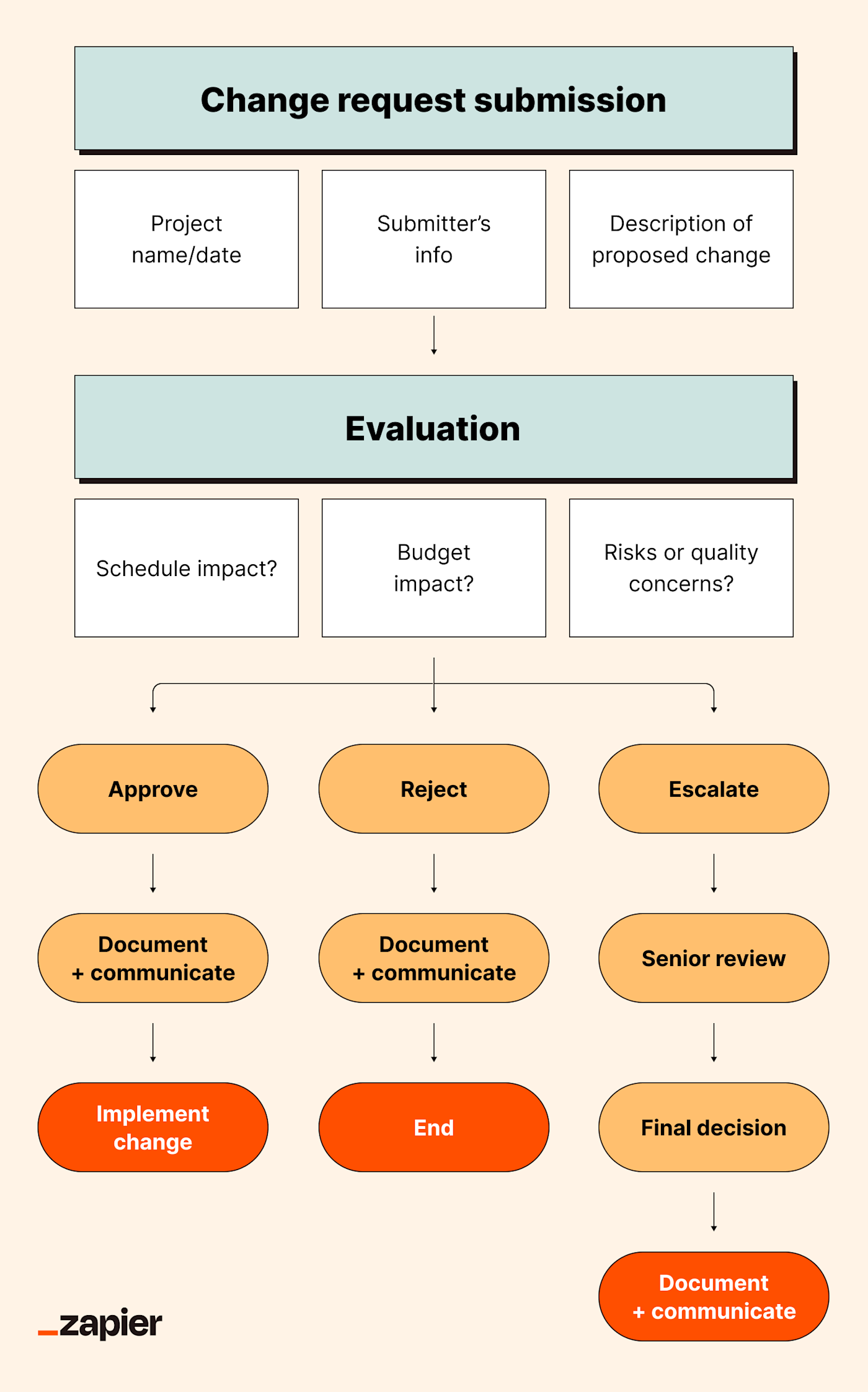Scope creep is like that friend who shows up to your low-key game night with their roommate, their roommate's boyfriend, and their roommate's boyfriend's beer league hockey teammates. Before you know it, you're ordering three extra pizzas and wondering how a cozy evening ballooned into a 15-person rager that would make the Fyre Festival organizers say, "Wow, that got out of hand."
We've all been there. And if you haven't, congratulations on having boundaries, I guess?
In the business world, this same kind of boundary-slipping shows up as scope creep—when a project quietly expands beyond the original plan, often without additional resources, timelines, or support.
In this guide, I'll walk you through what scope creep is, why it's so dangerous to your projects, and how you can effectively manage and minimize its impact.
Table of contents:
What is scope creep?
Scope creep is when a project's scope—the agreed-upon work, goals, and deliverables—starts to expand beyond its original boundaries without proper planning, approval, or additional resources. It's like when you go to Target for toilet paper and somehow leave with $300 worth of candles, throw pillows, and a velvet jumpsuit you'll never wear because where the heck are you going in a velvet jumpsuit?
Scope creep often begins innocently. "Could we just add this one small feature?" or "While we're in there, let's also update this." These requests often seem minor in isolation, but they accumulate like snowflakes on a mountainside until you're facing an avalanche of extra work you can't outrun.
Project-related changes aren't inherently bad. In fact, they're inevitable in most projects. The problem is uncontrolled change—additions that bypass formal review processes and don't receive corresponding adjustments to timelines, budgets, or your rapidly deteriorating mental health.
Why scope creep haunts project managers
Here's what happens when scope creep takes over:
Delivery delays: When scope expands, something has to give. And that's often your timeline. Every time someone adds "just one more thing," it's like adding another snooze to your alarm. Eventually, you're so far behind schedule that your project's original deadline is a distant memory, like when you used to have hopes and dreams and cartilage in your knees.
Bloats the budget: Extra work requires extra resources, like more hours from your team, additional materials, extended software licenses, or outside expertise. Without corresponding budget increases, these costs eat into your profit margins or force painful trade-offs.
Burns out your team: Adding more work without extending deadlines or bringing in more resources means your team is working longer hours, rushing execution, and generally hating their lives (and probably you)—all recipes for burnout. Burned-out team members become less productive, more error-prone, and more likely to leave, creating a destructive cycle that threatens current and future projects.
Undermines trust and credibility: When you consistently over-promise and under-deliver because of scope creep, people stop believing anything you say about resources or schedules. Everyone mentally doubles whatever estimates you give them because you're the project manager who cried wolf.
Compromises quality due to rushed additions: When you try to cram in extra features without additional time, corners get cut. The result is often a product that may technically meet the expanded requirements but suffers from bugs, weak spots, or usability issues.
What causes scope creep?
Scope creep usually starts small—a tiny "could we also add..." request that seems harmless enough. But like that innocuous "one little drink" after work that somehow turns into you doing karaoke at closing time while wearing someone else's orthopedic boot, these seemingly insignificant changes compound until you're in way over your head.
Here are the usual suspects behind scope creep:
Unclear initial scope: The foundation of scope control is a clear, detailed initial scope. Without it, there's no baseline to measure changes against. If your project kicks off with ambiguous objectives like "improve the website" or "update the system," almost any work could be considered in scope. Be sure to establish specific, measurable goals and requirements—unless you enjoy playing a guessing game where the rules keep changing and everyone's mad at you for not being psychic.
Too many cooks: Stakeholder interference is democracy at its worst. Everyone gets a vote, including people who shouldn't even be allowed to vote on what they have for lunch, let alone major project decisions. It's like letting everyone in the plane take turns flying it. Sure, it's inclusive, but we're definitely crashing into a mountain.
Ineffective change control: Some organizations have change control processes like I have self-control around cheese. Technically, it exists, but it's not stopping anything. Even the most clearly defined projects need a solid process for evaluating and approving changes. Without one, ad hoc changes slip through, gradually expanding the scope without corresponding adjustments to time or resources.
Overpromising: Sometimes, scope creep starts before the project even begins. Eager to win business, project managers or sales reps go full "yes and" like they're in an improv troupe instead of properly managing expectations. This creates a situation where the team is already overcommitted from day one, leaving no buffer for the inevitable changes and challenges that crop up during execution.
Miscommunication or disagreements: When team members, stakeholders, and clients have different understandings of project goals, deliverables, or priorities, scope creep is almost inevitable. One party believes they're requesting something in scope, while another sees it as an addition.
Market shifts: External changes in the market, competitive landscape, or regulatory environment can necessitate changes to the project scope. But even if the changes are valid and necessary, they still need to go through a formal process to avoid scope creep.
Gold plating: Sometimes, the call comes from inside the house. Team members, particularly perfectionists or those passionate about their work, can't resist adding extra features that nobody asked for. While well-intentioned, this "gold plating" isn't helpful—it's scope creep in a trench coat pretending to be productivity.
Vague scope requirements | Clear scope requirements |
|---|---|
Update the website | Redesign homepage CTA by October 1 |
Increase social media presence | Post twice weekly on Instagram and LinkedIn with branded graphics starting next month |
Improve site speed | Achieve homepage load time under 3 seconds by July 15 |
Enhance customer service | Reduce average customer email response time to under 4 hours by August 31 |
Fix bugs | Resolve ticket IDs 101, 102, and 103 by next release |
Grow subscriber list | Increase email subscribers by 15% within 90 days through targeted social ads |
Increase customer engagement | Launch monthly webinars to boost user engagement by 10% by May 1 |
7 proactive strategies to minimize scope creep
While completely eliminating scope creep is nearly impossible (change is, after all, inevitable), you can minimize its frequency and impact with these proactive strategies.
1. Create crystal clear requirements documentation
The antidote to scope creep is good documentation, established at the very beginning of the project lifecycle. It doesn't have to be perfect or omniscient or delivered with the divine foresight of a cursed animatronic oracle after you wish to become a grown-up project manager. It just has to be detailed enough so there's no wiggle room for ambiguity or misinterpretations.
This involves creating a detailed and mutually agreed-upon scope of work that outlines the project's objectives, deliverables, tasks, timelines, explicit exclusions, limitations, delusions, etc. This document serves as the definitive reference for all project participants. Plus, it gives you something to throw down dramatically when someone tries to "innovate" in the middle of QA.
Establishing a work breakdown structure (WBS) is a good next step for improving clarity. The WBS divides the overall project scope into manageable, bite-sized steps, providing a hierarchical view of the entire project.
Next, drill down into detailed requirements and acceptance criteria. If you're delivering software, include user stories, wireframes, and functional specifications that leave little room for interpretation. If it's a marketing campaign, lay out target audiences, channels, messaging, and success metrics.
Once the project management scope and requirements are agreed upon, baseline the documentation. That means you treat it as a frozen artifact. You can still make changes, but they'll need to go through a formal process (more on that below).
2. Ruthlessly prioritize and regularly re-evaluate
Prioritize features like I prioritize not being perceived. Use a framework like MoSCoW (must have, should have, could have, won't have), RICE (reach, impact, confidence, effort), MIT (most important task), or whatever prioritization acronym makes you feel productive. It doesn't matter as long as it helps you sort the mission-critical from the "wouldn't it be nice" features.
When new requirements emerge, they enter this same prioritization process, competing against existing items rather than automatically being added to the scope.
And be honest with yourself. "Not now" is a perfectly valid answer. Some things can go into the backlog for later consideration. And some things can be quietly ignored until the person either forgets they asked or is too embarrassed to bring it up again.
3. Build a change request process before you need it
You need a system for evaluating changes before they start rolling in. This is like buying that viral fire blanket from the TikTok Shop—you hope you'll never use it, but when your roommate tries to flambé something, you'll be grateful it's there.
Set up a change control system that's not so bureaucratic it makes people want to circumvent it (because they will), but structured enough that it actually protects you from ad hoc adjustments, reckless pivots, and tension headaches.
Your change control process should include:
Submission (by the requester): What's the proposed change? What kind of change is it (correction, feature enhancement, scope clarification, etc.)? What's the reason and perceived benefit?
Evaluation (by the PM or project team): What's the estimated impact on the timeline, team resources, and budget? Are there any new risks or dependencies?
Decision (by the appropriate authority): Is the change approved, rejected, or escalated? How will we communicate the decision and archive it?

4. Track everything in writing
Document everything like you're preparing for a congressional hearing. Memory is fallible, and verbal agreements are an invitation for misunderstanding and project creep. Written documentation creates a historical record of project decisions and can be indispensable for justifying delays, defending budgets, or retracing your steps.
Keep a real-time log of:
Initial scope and requirements
Approved changes and their impact
Rejected or deferred requests (and why)
Key decisions and their rationale
Action items and responsibilities
Versions of your core documentation
And yes, this will take a little extra effort. But it saves you from that gnawing feeling when someone says, "I thought we were including X," and you have nothing but a vague recollection to push back with. Being able to show the approved scope document with their signature carries significant weight.
Take advantage of project management software to monitor scope and document changes. For example, most PM tools allow you to maintain a living scope log or backlog where every request or change is recorded and can be reviewed. Here's a list of Zapier's project management app roundups to get you started:
5. Constant and transparent communication
You know how in horror movies the problems usually start when people stop talking to each other? "Let's split up," they say, and then everyone dies. Projects are the same (minus the pile of corpses, usually).
Keep everyone in the loop with regular updates. You're not Chip and Joanna Gaines, and this isn't HGTV, so don't wait until the end for a big reveal. Instead, set up recurring check-ins that answer:
What did we just finish?
What are we working on next?
What's changed (if anything)?
Are there any roadblocks or decisions that need to be made?
Whenever possible, make things visual with shared mockups, wireframes, or demos. Showing tangible progress helps stakeholders visualize what they're getting and often reduces the impulse to request changes when they can see the product taking shape.
6. Empower your team (wisely)
Your team is your first line of defense against scope creep—assuming they know what they're defending. You can't expect them to guard a line they can't see. Make sure everyone knows:
What's in scope
What's out of scope
What to do when something new is proposed
Stick scope reviews into sprint planning, team standups, or kickoff calls. Make space for questions. A five-minute clarification can save five hours of cleaning up someone's spontaneous "vision."
Everyone should feel empowered to raise a flag when they see scope starting to creep. Create a safe space for people to say "Um, that sounds like scope creep" without fear of being labeled a killjoy.
7. Learn to say "no"
This is the final boss of scope management—especially for people-pleasers, or if your client has a way of asking that makes everything sound reasonable. But the more comfortable you get with saying "no," the less likely you are to wake up one morning with a bloated scope and no idea how it happened.
Here are a few ways to say it:
"That's an interesting idea! It doesn't align with our current sprint goals, but let's add it to the backlog for future consideration."
"I love the enthusiasm! Let's talk about what we'd need to deprioritize to make room for this."
"Great suggestion! That would add approximately two weeks to our timeline. Should we delay the launch to accommodate it?"
"Fascinating concept! That's definitely outside our current scope, but we could explore it as a Phase 2 initiative."
"I hear what you're saying. Let me run an impact analysis and get back to you with what this would mean for our timeline and budget."
Instead of just saying "no" (even if you're screaming it internally), it's important to frame responses constructively. Explain the reasoning and impact. Show them the trade-offs. Make them understand that saying "yes" to their request means saying "no" to something else, like launching on time or staying under budget or maintaining the team's will to live.
Use automation to curb scope creep
Just like I'm never going to be someone who meal preps for the week or willingly attends a baby shower, projects are never going to go exactly as planned. But with clear boundaries, consistent PM processes, and the right tools to keep everything on track, you can at least keep scope creep in check.
Zapier lets you connect your favorite apps to create custom project management automations—no code required. For example, you can automatically log change requests from a form straight into your task manager, notify the team when a new scope doc version is uploaded, and trigger alerts when someone changes a priority in your backlog. Here's a template you can use to get started.
Submit project updates in a form and let AI Agents create intelligent status update emails.
Automation won't magically solve scope creep, but it makes it a lot easier to spot and a lot less likely to ruin your day. Learn more about how to automate your project management processes to keep your workflow consistent, your documentation updated, and your team informed.
Related reading:










